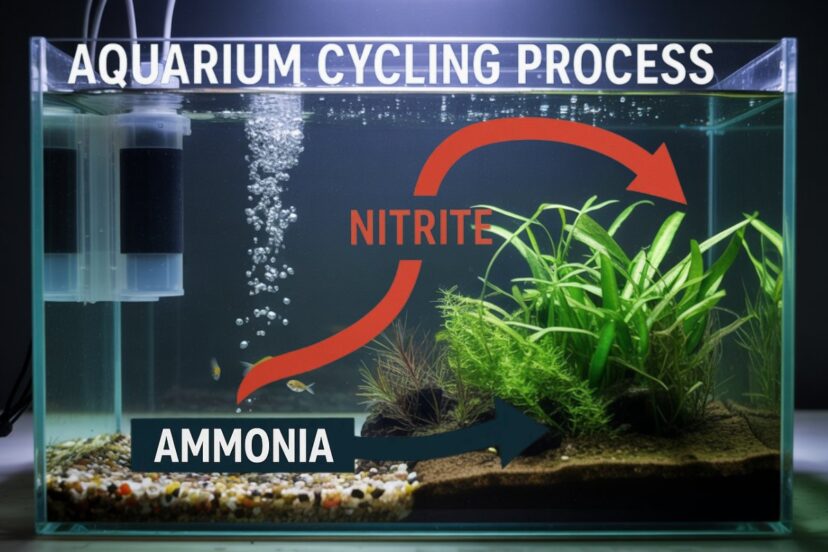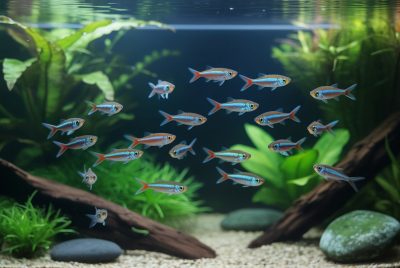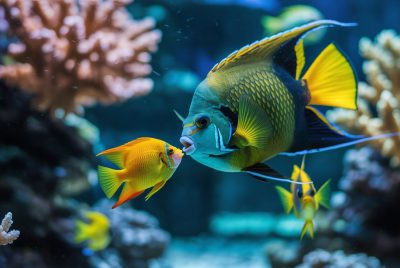The Aquarium Cycling Process: A Beginner’s Guide
*We may earn a commission for purchases made using our links. Please see our disclosure to learn more.
I still remember the day I brought home my first aquarium. The anticipation of creating a thriving underwater world, the excitement of selecting fish, and the pride I felt setting everything up. What I didn’t anticipate was watching all my new fish die within a week, despite following every instruction on the tank’s packaging. That painful experience taught me the most crucial lesson in fishkeeping that many beginners overlook: the nitrogen cycle.
The aquarium cycling process isn’t just some technical step you can skip—it’s the foundation of a healthy aquarium ecosystem. I learned this lesson the hard way, through tears and tiny fish funerals. Today, I want to share my journey with you so that you can avoid my mistakes and create a thriving aquatic environment for your underwater friends from day one.
Whether you’re setting up your first tank or you’ve had failed attempts in the past, understanding the nitrogen cycle will transform your fishkeeping experience. It’s not just about clear water or pretty decorations—it’s about creating a balanced ecosystem where your fish can truly thrive.
Key Takeaways
- The nitrogen cycle is essential for converting toxic fish waste (ammonia) into less harmful compounds
- Cycling typically takes 4-6 weeks and requires patience and monitoring
- There are several methods to cycle your tank, including fishless cycling (recommended) and fish-in cycling
- Testing water parameters regularly with a quality test kit is crucial to successful cycling
- Adding beneficial bacteria can help accelerate the cycling process
“The difference between a successful aquarium and a failed one often comes down to one thing: patience during the cycling process.”
— Dr. Timothy A. Miller, Marine Biologist at the Pacific Marine Research Institute
Recommended Aquarium Cycling Process Products
API Freshwater Master Test Kit
The API Freshwater Master Test Kit is a comprehensive and trusted solution for monitoring the health of your freshwater aquarium. With the ability to perform up to 800 tests, this kit includes everything you need: 7 bottles of testing solutions, 4 test tubes with caps, and a detailed color chart for accurate readings. It measures five critical water parameters—pH, high-range pH, ammonia, nitrite, and nitrate—ensuring your betta fish lives in clean, safe, and stable water conditions. Regular use of this kit helps prevent invisible water issues that can lead to stress, disease, or even loss of your fish.
- Comprehensive Testing: Covers all essential water parameters for freshwater tanks.
- Long-Lasting Value: Provides up to 800 tests, making it cost-effective over time.
- Accurate Results: Trusted by hobbyists and professionals for precise water readings.
- Manual Process: Requires measuring and comparing to color charts, which can be time-consuming.
- Storage Space: Comes in a relatively bulky box that may take up tank cabinet space.
- No Digital Display: Lacks digital convenience some modern testers offer.
Essential for monitoring ammonia, nitrite, and nitrate levels during cycling. This comprehensive kit includes all the tests you’ll need and is more accurate than test strips.
Seachem Stability
Seachem Stability is a highly effective fish tank stabilizer designed to rapidly establish the aquarium biofilter, preventing "new tank syndrome" and promoting a healthy environment for both freshwater and marine systems. This liquid stabilizer contains a blend of beneficial bacteria that break down waste, ammonia, nitrites, and nitrates, ensuring water quality and a thriving tank ecosystem. It’s safe for all aquatic organisms and plants, and it is easy to use—just add it to your aquarium according to the recommended dosage. With Seachem Stability, you can set up your tank with confidence, knowing your fish and plants will thrive in a stable environment.
- Rapid Biofilter Establishment: Quickly establishes a stable biofilter, preventing new tank syndrome.
- Breaks Down Harmful Toxins: Effectively eliminates ammonia, nitrites, and nitrates, maintaining water quality.
- Safe for All Aquatic Life: Harmless to fish, plants, and invertebrates, ensuring no risk of overuse.
- Needs Daily Application: Requires daily dosing for 7 days, which may be inconvenient for some users.
- Not Instantaneous: Full effects take a few days to become noticeable as the bacteria colonize.
- Sensitive to UV/Ozone Filters: UV or ozone filters need to be turned off during treatment for maximum effectiveness.
A reliable beneficial bacteria supplement that helps jumpstart the nitrogen cycle. I’ve used this in multiple tanks with great success.
Aqueon Pure Balls
The Aqueon Aquarium Pure Live Bacteria and Enzymes Water Supplement is a convenient and effective solution for maintaining a healthy aquarium environment. Each easy-to-dose gel ball contains live beneficial bacteria that help break down harmful waste, ensuring clear and clean water for your fish. Designed for freshwater aquariums, this supplement is safe for all types of aquatic life and cannot be overdosed, making it a simple addition to your aquarium care routine. Perfect for tanks up to 10 gallons, this 12-pack provides long-lasting results with just one ball per application.
- Easy to Use: Pre-measured gel balls for simple, mess-free dosing.
- Safe for All Fish: Designed for all freshwater aquariums, ensuring the health of your aquatic life.
- No Overdose Risk: Can’t be overdosed, making it a hassle-free addition to your tank.
- Limited to Freshwater Aquariums: Not suitable for saltwater tanks.
- Small Pack Size: 12-pack may run out quickly for larger aquariums or frequent use.
- No Instant Results: May take time for visible water improvements.
Time-release beneficial bacteria that continue working for up to 30 days. Perfect for beginners who might forget daily bacteria additions.
Hygger Aquarium Air Pump
The hygger Small Quietest Aquarium Air Pump is a powerful yet ultra-silent aerator designed to keep your aquarium water oxygenated and healthy. With adjustable airflow, this pump can reach up to 160GPH, providing efficient oxygenation for tanks up to 150 gallons. The double air outlets ensure even and stable bubbles, making it suitable for various aquarium setups, including nano air stones and biochemical filters. Its 6-step noise reduction system ensures a quiet operation, while the durable materials and copper wire motor provide long-lasting reliability. Perfect for maintaining optimal water conditions in freshwater and saltwater tanks.
- Adjustable Air Flow: Customize oxygen levels to suit your tank’s needs.
- Ultra-Quiet Operation: 6-step noise reduction for minimal disturbance.
- Durable & Efficient: Full copper wire motor for energy savings and long-lasting performance.
- Limited to 150 Gallon Tanks: Not ideal for larger tanks beyond 150 gallons.
- Cannot Exceed 5 Feet Depth: Limitations on tank depth for optimal performance.
- Size Restriction: Only available in 5W and 10W sizes, which may not suit all tank setups.
Ensures proper oxygenation during the aquarium cycling process, which is crucial for beneficial bacteria development.
My Cycling Journey: From Frustration to Success
When I first ventured into the world of aquariums, I made the classic beginner mistake. I set up my tank, let the water clear for 24 hours, and added my fish—believing that “letting the tank settle” was all that was needed. Within days, my beautiful neon tetras were gasping at the surface, their vibrant colors fading. By the end of the week, I had lost all of them.
I was devastated and confused. The pet store had assured me that my setup was perfect, so what went wrong? The answer came from an online forum where experienced aquarists explained the nitrogen cycle—an invisible biological process that establishes the beneficial bacteria needed to process fish waste.
“You can’t see the cycle happening,” one forum member wrote, “but it’s the difference between life and death for your fish.”
That’s when I realized I had subjected my fish to an environment filled with invisible toxins. Their deaths weren’t just bad luck—they were the result of my ignorance about this crucial process.
Understanding the Nitrogen Cycle
The nitrogen cycle is essentially nature’s waste management system in your aquarium. Here’s how it works:
- Ammonia Stage: Fish produce waste, and uneaten food decomposes, creating ammonia—highly toxic to fish even in small amounts.
- Nitrite Stage: Beneficial bacteria (Nitrosomonas) develop and convert ammonia into nitrites, which are still toxic but less immediately lethal than ammonia.
- Nitrate Stage: A second type of beneficial bacteria (Nitrobacter) converts nitrites into nitrates, which are much less harmful to fish in moderate amounts.
- Completion: Your tank is “cycled” when ammonia and nitrites read zero, and you have some measurable nitrates that can be managed with regular water changes.
The entire process typically takes 4-6 weeks, though it can be shorter or longer depending on various factors. This timeline was perhaps the most humbling lesson for me—I had to learn that in aquarium keeping, nature works on its own schedule, not mine.
Methods for Cycling Your Tank
After my initial failure, I researched extensively and discovered several approaches to cycling:
Fishless Cycling (Recommended)
This is the method I now use for all my tanks. It involves:
- Setting up your tank completely with substrate, decorations, and equipment.
- Adding an ammonia source (pure ammonia, fish food, or a piece of raw seafood).
- Testing regularly until you see the ammonia rise, then fall as nitrites appear.
- Continuing until both ammonia and nitrites read zero, and nitrates are present.
The advantage of fishless cycling is that no fish are subjected to toxic conditions. It’s the most humane approach, though it requires patience and regular testing.
Fish-In Cycling
This is what I unknowingly attempted with my first tank. It involves:
- Starting with a very small number of hardy fish.
- Conducting frequent water changes (often daily) to keep ammonia levels as low as possible.
- Testing water constantly and changing water whenever ammonia or nitrites are detectable.
I don’t recommend this method unless you’ve inherited an established tank with fish already or have no alternative. It’s stressful for both the fish and you, requiring constant vigilance and intervention.
Seeded/Jump-Started Cycling
This method accelerates the process by introducing beneficial bacteria from an established tank:
- Using filter media, substrate, or decorations from a cycled tank.
- Adding commercial bacterial supplements.
- Still testing regularly, but often seeing the cycle complete in half the time.
After my initial failure, I used this method with great success when setting up my second tank. A fellow aquarist gave me some filter media from their established tank, and my cycle completed in just under three weeks.
Common Cycling Challenges and Solutions
Throughout my cycling journey, I encountered several obstacles that tested my patience:
The Waiting Game
The hardest part of cycling is simply waiting. I would check my test kit daily, sometimes twice daily, anxious to see progress. Days would pass with seemingly no change, making me wonder if I was doing something wrong.
Solution: I started keeping a cycling journal, recording all my test results. This helped me see subtle changes over time and gave me something productive to do with my impatience.
Temperature Fluctuations
I didn’t realize that temperature significantly affects bacterial growth. My tank was in a cool room, which slowed down my cycling process considerably.
Solution: I invested in a quality heater and kept my tank at a consistent 78-80°F during cycling, which noticeably accelerated bacterial development.
Overfeeding During Fish-In Cycling
When I attempted to cycle with fish the second time (before learning about fishless cycling), I made the mistake of feeding normally, which increased the ammonia burden beyond what my developing bacterial colonies could handle.
Solution: For fish-in cycling, I learned to feed very sparingly—just enough to keep the fish alive but minimize waste production.
pH Crashes
Midway through cycling my third tank, my pH suddenly dropped, stalling the entire process. I learned that the nitrogen cycle itself can deplete carbonates in the water, which affects pH stability.
Solution: I started monitoring pH alongside ammonia, nitrite, and nitrate, and used buffer products when necessary to maintain stable conditions.
The Emotional Journey of Cycling
The cycling process isn’t just a scientific endeavor—it’s an emotional journey that taught me profound lessons about patience, responsibility, and the delicate balance of nature.
There were moments of doubt when I wondered if my tank would ever cycle. Days of staring at test tubes, hoping to see the nitrites finally begin to drop. The excitement of seeing the first signs of nitrates appear, signaling the end was near.
Most importantly, there was the guilt I carried from my first failed attempt. Each successful tank I’ve cycled since then has been a step toward redemption—a way to honor those first fish by becoming a more knowledgeable and responsible aquarist.
Beyond the Cycle: Maintaining the Balance
Once your tank is cycled, the work isn’t over. Maintaining that biological balance requires:
Regular Testing
I still test my established tanks weekly to ensure everything remains in balance. Any spike in ammonia or nitrites is an early warning sign that something has disrupted your cycle.
Careful Stocking
After cycling, add fish slowly—I add no more than a few small fish at a time, waiting at least a week between additions to allow the bacterial colony to adjust to the increased bioload.
Mindful Maintenance
When cleaning your filter, never replace all the media at once or rinse it in tap water (the chlorine will kill your beneficial bacteria). I always rinse filter media in old tank water during water changes.
Watching for Mini-Cycles
Adding too many fish at once, changing too much water, deep-cleaning your substrate, or medicating your tank can all trigger “mini-cycles”—small disruptions to your bacterial balance that can cause ammonia or nitrite spikes.
The Rewards of Proper Cycling
The patience required for proper cycling has paid off tremendously in my aquarium journey:
- Healthier Fish: My fish are more colorful, active, and have longer lifespans compared to my early attempts.
- Less Maintenance: A properly cycled tank requires less intervention and fewer emergency water changes.
- Greater Success with Sensitive Species: I’ve been able to keep species that are known to be challenging for beginners, simply because my water parameters are stable.
- Peace of Mind: There’s something deeply satisfying about knowing you’ve created a balanced ecosystem where life can thrive.
My proudest moment came when my tank successfully supported its first batch of fish fry. Seeing new life emerge in an environment I had carefully prepared and maintained was the ultimate validation of my cycling journey.
Conclusion
The aquarium cycling process is both a science and an art—a test of patience that separates casual fish owners from dedicated aquarists. It’s the unseen foundation upon which all successful aquariums are built.
My journey from that first heartbreaking failure to maintaining multiple thriving tanks has taught me that there are no shortcuts in this hobby. The nitrogen cycle operates on its own timeline, and our job is simply to support it, monitor it, and respect its essential role in aquatic life.
If you’re just starting your aquarium journey, I encourage you to embrace the cycling process rather than trying to rush through it. Those weeks of waiting will be repaid many times over in the health of your aquatic ecosystem and the joy of watching your underwater world thrive.
Remember, the most beautiful aquariums aren’t just the ones with expensive equipment or exotic fish—they’re the ones where the invisible biological processes are in perfect balance. That balance begins with cycling.
Frequently Asked Questions (FAQs)
1. How long does the aquarium cycling process typically take?
The complete cycling process usually takes 4-6 weeks, though it can be shorter with the use of bacterial supplements or filter media from established tanks. Factors like temperature, pH, and tank size can affect cycling time.
2. Can I add fish during the cycling process?
While fish-in cycling is possible, it’s not recommended for beginners as it subjects fish to potentially toxic conditions. Fishless cycling is the more humane approach and provides more consistent results.
3. How do I know when my tank is fully cycled?
Your tank is considered cycled when ammonia and nitrite levels read zero consistently, even after adding an ammonia source, and you have a measurable amount of nitrates. Always confirm with test kit readings rather than visual cues.
4. What if my cycling process seems to be stalled?
Common reasons for stalled cycles include pH issues, temperature fluctuations, or inadequate ammonia sources. Check your water parameters, ensure your temperature is between 75-82°F, and verify that you’re providing enough ammonia to feed the developing bacteria.
5. Do I need to cycle a quarantine tank before using it?
Yes, quarantine tanks should ideally be cycled before use. However, if you need to use one urgently, you can “instant cycle” by moving filter media from your main tank to the quarantine tank, along with using bacterial supplements.
















